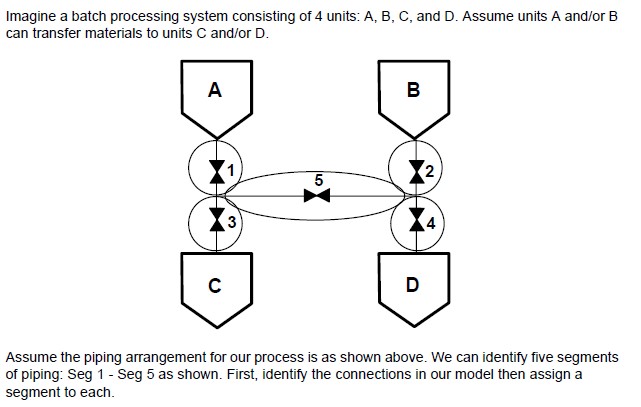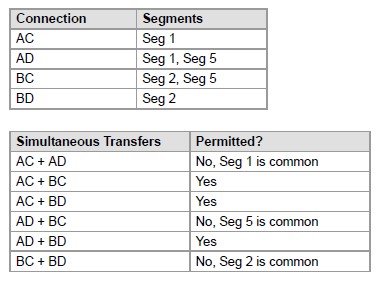Example 3

- In this example, we assume units C and D are not on load cells as in the previous example.
- Here, the metering is done at the source. We can say either A and B have load cells and we measure loss-in-weight for our transfer, or we can say units A and B each have a flow meter on their outlets (measuring and totalizing material flow out). It doesn't matter.
- The important thing is that metering is being done at the source of the transfer rather than the destination as was done in Example 2.
- In this case, it is not desirable to have unit A or B transferring to C and D at the same time.
- Since we are only measuring loss-in-weight or flow out of unit A, we cannot tell how much material ends up in unit C and how much ends up in D if they transfer simultaneously.
- It is acceptable for A and B to transfer to C (or D) simultaneously since A and B are individually metered. We therefore wish to prevent AC+AD and BC+BD as well as the usual AD+BC.
- Modeling segments Seg 1 and Seg 2 along with Seg 5 gives the desired result.

- Examples 2 and 3 lead to our second rule:
- Rule 2: Model segments if and where materials are metered.
- If material is metered at or from the source, model a segment at the outlet of the source unit.
- If material is metered at, or into the destination, model a segment at the inlet to the destination unit.
- Conclusion
- In conclusion, we have identified two rules for the use of segments.
- Rule 1: Only model those segments that will prevent specific undesirable combinations of transfers from occurring simultaneously.
- Rule 2: Model segments if and where materials are metered.
- Remember, segments are a powerful tool. Use them sparingly to chisel away simultaneous transfer capabilities to more accurately and faithfully model your batch process
Last modified: Saturday, 2 May 2020, 10:34 AM
